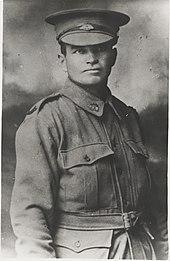Lewis Harold Bell Lasseter
Lewis Harold Bell Lasseter (27 September 1880 - early 1931), also known as Harold Lasseter, was an Australian gold prospector who claimed to have found a fabulously rich gold reef in central Australia.

Life
He was born Lewis Hubert Lasseter in 1880 at Bamganie, Victoria, Australia. Self-educated, he was literate and well-spoken, and commonly described as eccentric and opinionated. He travelled in both Australia and the United States and worked at a variety of occupations, marrying twice and fathering five children.
Lasseter's Reef
Lasseter was made famous by his sensational claim, first asserted in 1929, that, as a young man, he had discovered a fabulously rich gold reef, an entity now known as "Lasseter's Reef", in central Australia.
He perished in the desert near the Western Australia–Northern Territory border in early 1931 after he separated himself from an expedition that was mounted in an effort to rediscover the supposed reef. His body was found and buried in March 1931 by Bob Buck, a central Australian bushman and pastoralist sent to search for Lasseter. It was later re-interred in the Alice Springs cemetery.
The book Lasseter Did Not Lie by A. Stapleton (published in Adelaide, 1981) refutes the idea that Lasseter was no more than a con-man. The book claims that he may have been largely telling the truth, with supporting evidence.[1] It was written because Fred Blakeley, leader of Lasseter's 1930 expedition, and others had branded Lasseter a charlatan who ripped off his investors in a clever scheme to convince them that such a gold reef existed.[2] Blakeley even claimed that Lasseter did not die in Central Australia but escaped to America.
Although Lasseter has been accused of romancing or lying about his gold reef, it is plain that many of Lasseter's associates spread misinformation about him as they were being blamed for his death having left him unsupported for months in the desert. Even government officials helped spread untruths concerning Lasseter in an attempt to destroy the idea of a rich gold find in Central Australia for in the 1930s too many prospectors were getting into difficulties and requiring expensive search and rescue operations.[3] A notable exception amongst Lasseter's associates was the expedition pilot, Errol Coote, who believed in the essential truth of Lasseter's story.[4]
With a plethora of contradictory statements over the years, it is now difficult or impossible to separate history from myth with regard to Harry Lasseter. As an example, in his World War I military records Lasseter is documented as having been medically examined on 30 October 1917 and found to be "mentally deficient" and as having "marked hallucinations" and a "peculiar manner and is constantly talking." That finding ignored other documentation which recorded that in September he had been taken to hospital unconscious with a head injury and had spent from 11 September to 22 October in two different hospitals recovering. After the medical board's finding he was discharged from the army on 2 November 1917.[5] Yet in early 1918 he wrote and published an impressive poem denouncing war. He was also a prominent spokesman for a group of citizens planning a large wooden ship building project at Port Welshpool, Victoria, a project which only collapsed because the war ended and contracts for wooden ships were withdrawn. Lasseter's efforts at that time were not those of a "mentally deficient" man.[6]
In popular culture
Lasseter is referenced in the song "Warakurna" on the 1987 Aboriginal rights themed album Diesel and Dust by Australian rock band Midnight Oil.
His story was the subject of non fiction "The search for Harold Lasseter : The true story of the man behind the myths" by Murray Hubbard (1993)
Luke Walker's 2013 documentary feature Lasseter's Bones explores the life and legend of Lasseter and documents the filmmaker's many attempts to locate the notorious Lasseter's Reef.[7] The film also follows Lasseter's elderly son Bob on his last desert expedition to find his father's lost gold and explores the many complex strands of the Lasseter mystery.[8] Lasseter's Bones was nominated for Best Documentary at the Film Critics Circle of Australia Awards.[9]
In January 2017, an episode of Expedition Unknown on the American Travel Channel, titled "Lasseter's Gold", examined the mystery.[10]
Legacy
- Lasseter's Cave, Northern Territory
- Lasseter Highway, Northern Territory
- Lasseter’s Hotel Casino, Alice Springs, Northern Territory
References
- Lasseter Did Not Lie by A Stapleton, Investigator Press, Hawthorndene, S.A., 1981
- Blakeley, Fred, Dream Millions, Angus & Robertson, Sydney, 1972.
- McKeague, Jim, Sam Hazlett and the Search for Lasseter's Reef, 2015, chapters 7 and 20, and map 9B.
- Coote, Errol, Hell's Airport, Peterman Press, Sydney, 1934, preface.
- National Archives of Australia, WWI Service Records, Series No B2455, Lasseter, Lewis Hubert.
- Hubbard, Murray, The Search for Harold Lasseter, Angus & Robertson, Pymble, NSW, 1993, pp. 119-132.
- http://www.theaustralian.com.au/arts/review/luke-walker-digs-up-a-hot-prospect-with-lasseters-bones/story-fn9n8gph-1226741606541
- http://www.graffitiwithpunctuation.net/2013/12/30/review-lasseters-bones-luke-walker-2012-2/
- http://www.lassetersbones.com.au
- "Lasseter's Gold". travelchannel.com. Retrieved 11 November 2019.
- Australian Dictionary of Biography – online version
- LASSETERIA. The Lasseter Encyclopedia. http://www.lasseteria.com